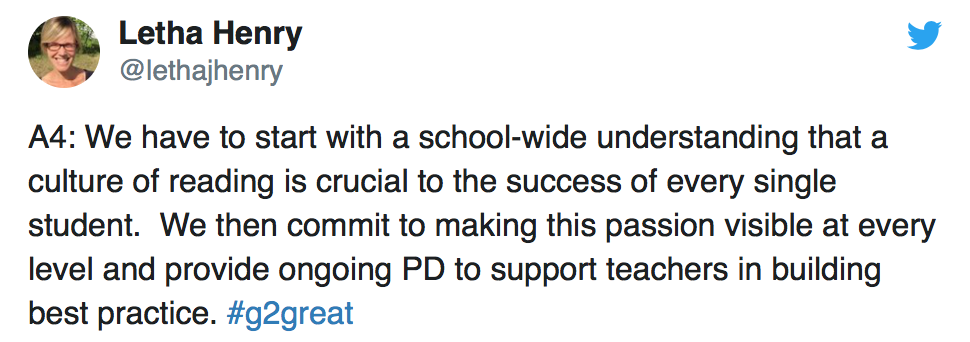by Amy Brennan
As summer approaches, students, teachers and administrators begin to think about summer plans. Different types of plans come to mind – vacations, beach days, summer camps, and for many there remains an uncertainty that comes from school closing for the summer months. How to we prepare our students for summer? How do we ensure that all their growth over the school year doesn’t get lost over the long, sun-filled summer? How can we ensure that they have opportunities NOT for worksheets, NOT for summer projects, but for READING, the pure joy of reading. This alone can help to eradicate summer reading loss. We need to inspire our students to read all school year long so that we develop a natural culture of readers. If we establish a culture of reading at our schools, the members of our school community will take the culture with them for the summer. At the #G2Great chat on April 12, 2018 we sat at our virtual table and shared ways to inspire readers across all grades. 
Collectively Define “Culture of Readers”
As with anything, we first wanted to define what we collectively meant by a culture of readers across all grades. Having a common defintion is important to leading and inspiring any kind of movement. The chat generated so many descriptors that define by example what a culture of readers looks like.
To begin, just a few things can get us moving towards a culture of reading. We need to have books available to read. Once the books are there we need to create an invitation to read. After we have invited readers to the the world of reading we need to allow choice and time to read. Valuing books and readers requires that we set aside resources to purchase books, we set aside resources to store books in bins, on shelves, and on display. Relevent texts need to be available – every member of the school community should be able to see themselves in the books available. When we see ourselves individually, only then collectively we see our community. Discussions about books generate more reading. Book recommendations and choosing to read books together provides opportunities for discussions. Publicizing the books we read, posting the books we are reading on classroom or office doors, or bulletin board in the hallways – these steps all help to inspire a culture of readers. A culture of readers develops from these collective experiences at the building level. It only takes one person in a school to be the leader in this charge. Be that person – find your first follower and the others will follow. Develop your collective culture of readers together as more and more followers join your movement. Reach out to all school community members; administrators, teachers, parents, teaching assistants, teaching aides, secretarial, custodial and lunchroom staff and enlist them to be a part of the culture of readers.
Get Started
Once we define and put into place structures and develop shared beliefs around reading it is important to spread this across to leaders, teachers, staff and parents. This shift will be most effective and lasting if we are all inclusive – all members of the school community can talk about reading. Sharing books, talking about books, reading books around school throughout the day. All members of the school community should be able to talk to students about the books they are reading. Beginning with a shared book acorss a school can really begin this process. In my former school, we gathered the whole school community around a shared read-aloud – the first one was Wonder by R.J. Palacio. We welcomed students back to school after the winter recess with decorated halls sharing quote of kindness and engaged students in adding decorations and quotes as the read aloud spread through the building. 
Develop Your School’s Unique Reading Culture
Once you’ve started, well that is when your school will begin to develop its own reading culture. Include all stakeholders, listen to all ideas and the school will build its own culture around reading. There are so many ways and so many ideas out there, but the important thing is to collectively engage the school community so that the culture represents that school.
Ready, Set, Go!
If your school does not already have a culture of readers, be the first to get the movement started. Be positive, have energy and find those first followers who can help you begin the change. Get students involved, they are the reason this is so important and often they have the most creative ideas – unlike the adults sometimes in a school community their minds are not usually restricted by they way things have always been. Students’ minds flexibly think about possibilities without being held to a vision of what was or has been always done. Above all – READ – people will follow you.







